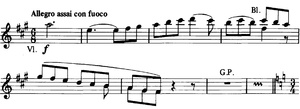Overture is a music instrumental introduction to a ballet, opera, or oratorio in the 17th century. During the early Romantic era, composers such as Beethoven and Mendelssohn composed overtures which were independent, self-existing instrumental, programmatic works that foreshadowed genres such as the symphonic poem. These were "at first undoubtedly intended to be played at the head of a programme".
The Tragic Overture, Op. 81, is a concert overture for orchestra written by Johannes Brahms during the summer of 1880. It premiered, under Hans Richter, on 26 December 1880 in Vienna. Most performances last between twelve and fifteen minutes.

The William Tell Overture is the overture to the opera William Tell, whose music was composed by Gioachino Rossini. William Tell premiered in 1829 and was the last of Rossini's 39 operas, after which he went into semi-retirement. The overture is in four parts, each following without pause.
Concertino is the diminutive of concerto, thus literally a small or short concerto.
On two occasions, Felix Mendelssohn composed music for William Shakespeare's play A Midsummer Night's Dream. First in 1826, near the start of his career, he wrote a concert overture. Later, in 1842, only a few years before his death, he wrote incidental music for a production of the play, into which he incorporated the existing overture. The incidental music includes the famous "Wedding March".

Calm Sea and Prosperous Voyage, Op. 27, is an orchestral concert overture by Felix Mendelssohn inspired by the same pair of poems by Johann Wolfgang von Goethe that inspired Beethoven's 1815 cantata of the same title. Mendelssohn's work was first performed on 7 September 1828 in Berlin.

Grand traité d’instrumentation et d’orchestration modernes, abbreviated in English as the Treatise on Instrumentation is a technical study of Western musical instruments written by Hector Berlioz. It was first published in 1844 after being serialised in many parts prior to this date and had a chapter added by Berlioz on conducting in 1855.
Overture to The School for Scandal, Op. 5, is a concert overture by Samuel Barber. It is Barber's first work for full orchestra, composed in 1931 while he was completing his studies at the Curtis Institute of Music in Philadelphia. The premiere was given on August 30, 1933 by the Philadelphia Orchestra conducted by Alexander Smallens. It lasts around 8 min.
Metropolis Symphony for Orchestra (1988–93) by American composer Michael Daugherty is a five-movement symphony inspired by Superman comics. The entire piece was created over the span of five years with separate commissions for each movement. Individual movements may be performed separately; however, it is preferred that the 41 minute symphony be performed in its entirety. MetropolisSymphony was premiered by the New Hampshire Symphony Orchestra, James Bolle conducting, in November 1993, at the Palace Theater in Manchester, New Hampshire. A connective narrative between movements was written and read by Jack Larson, who had played Jimmy Olsen on television in The Adventures of Superman. The orchestral version without narration was premiered by the Baltimore Symphony Orchestra, David Zinman conducting, in January 1994, at the Meyerhoff Concert Hall in Baltimore, Maryland.

The trumpet repertoire consists of solo literature and orchestral or, more commonly, band parts written for the trumpet. Tracings its origins to 1500 BC, the trumpet is a musical instrument with the highest register in the brass family.
The concert overture Carnival, Op. 92, B. 169, was written by Antonín Dvořák in 1891. It is part of a "Nature, Life and Love" trilogy of overtures, forming the second part, "Life". The other two parts are In Nature's Realm, Op. 91 ("Nature") and Othello, Op. 93 ("Love").
The concert overture In Nature's Realm, Op. 91, B. 168, was written by Antonín Dvořák in 1891. It is the first part ("Nature") of a "Nature, Life and Love" trilogy of overtures written by Dvořák. The other two parts of the trilogy are the Carnival Overture, Op. 92 ("Life") and Othello, Op. 93 ("Love").
The concert overture Othello, Op. 93, B. 174, was written by Antonín Dvořák in 1892 as the third part of a trilogy of overtures called "Nature, Life and Love". The first two parts of the trilogy are In Nature's Realm, Op. 91 ("Nature") and the Carnival Overture, Op. 92 ("Life").
André Bon is a French composer. A student of Olivier Messiaen, he has composed over fifty works including several chamber operas. He is Professor of Composition at the Argenteuil Conservatory.
In music, a duodecet—sometimes duodectet, or duodecimette—is a composition which requires twelve musicians for a performance, or a musical group that consists of twelve people. In jazz, such a group of twelve players is sometimes called a "twelvetet". The corresponding German word is Duodezett. The French equivalent form, douzetuor, is virtually unknown. Unlike some other musical ensembles such as the string quartet, there is no established or standard set of instruments in a duodecet.
The Julius Caesar overture, Op. 128, is a concert overture written in 1851 by Robert Schumann, inspired by Shakespeare's play Julius Caesar and influenced by the Egmont and Coriolan overtures of Ludwig van Beethoven.
The Hussite Overture, Op. 67, B. 132, was written by Antonín Dvořák in 1883 for the gala opening of the Prague National Theater. The composition was originally intended as a part of a dramatic trilogy on the Bohemian religious leader Jan Hus.








